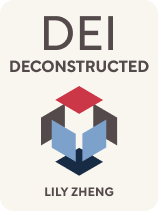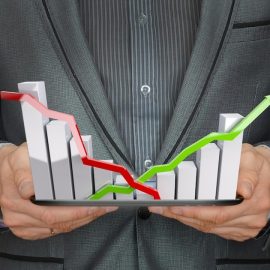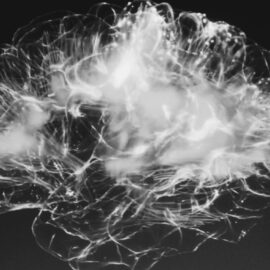

This article is an excerpt from the Shortform book guide to "DEI Deconstructed" by Lily Zheng. Shortform has the world's best summaries and analyses of books you should be reading.
Like this article? Sign up for a free trial here.
Are you tired of DEI programs that sound good on paper but fail to create real change? What does it actually take to build a workplace that champions diversity, equity, and inclusion?
Lily Zheng’s DEI Deconstructed: Your No-Nonsense Guide to Doing the Work and Doing It Right cuts through the noise with a no-nonsense approach to diversity work. The book reveals why most corporate initiatives backfire and offers a practical roadmap for organizations ready to move beyond surface-level gestures.
Read on to discover how to transform your workplace into one where meaningful progress replaces empty promises.
Overview of Lily Zheng’s DEI Deconstructed
Is your organization struggling to achieve a diverse, equitable, and inclusive environment? Do members feel disenfranchised, mistreated, or underrepresented? Lily Zheng’s DEI Deconstructed: Your No-Nonsense Guide to Doing the Work and Doing It Right (2022) champions diversity, equity, and inclusion (DEI) at a time when many organizations are struggling to move beyond performative gestures and create meaningful change. Zheng presents a pragmatic, results-oriented approach to DEI work that focuses on measurable outcomes rather than just good intentions. Using research-backed insights and real-world case studies, Zheng challenges conventional wisdom about DEI initiatives and provides a framework to help organizations make lasting improvements.
Zheng is a DEI strategist and consultant who works with organizations to create positive change and advance DEI in workplaces. Named as a Forbes Diversity and Inclusion Trailblazer and a LinkedIn Top Voice on Racial Equality, Zheng has a master’s degree in sociology and a bachelor’s degree in psychology from Stanford University. Their other books include Gender Ambiguity in the Workplace, The Ethical Sellout, and Reconstructing DEI, a workbook intended to serve as a companion to DEI Deconstructed.
In our overview of DEI Deconstructed, we’ll explore what DEI means and highlight issues with current approaches. We’ll also look at how identity and power play into DEI concepts, and we’ll explore how individual members of an organization can take part in advancing DEI initiatives and movements. Finally, we’ll explain how organizations can put DEI initiatives into practice on a larger scale, depending on the level of trust that members have in their organizations.
What Is DEI and Why Does It Matter?
To begin, let’s define what DEI is: DEI stands for diversity, equity, and inclusion. In general, DEI refers to an organizational framework that promotes the fair treatment of everyone within the organization. Identity is a central concept of DEI because DEI initiatives aim to create environments where individuals of all identities feel valued, respected, and supported.
Zheng explains that the definitions organizations use for the terms “diversity,” “equity,” and “inclusion” are often vague and, importantly, focused on intentions rather than measurable outcomes. Zheng emphasizes that organizations should reframe these terms to focus on what they plan to achieve and how they plan to do it. A common understanding of the meaning of these key terms will help organizations and their members work productively to create meaningful change.
The Importance of Equity
Zheng begins by defining “equity” to help inform the definitions of the other two terms. According to Zheng, equity is a state where every person and group within an organization is able to thrive and reach their full potential, while being protected from harm or unfair treatment. This includes employees, customers, and community members affected by the organization.
However, this doesn’t mean treating everyone exactly the same. Rather, establishing equity is about meeting and accommodating everyone’s unique needs—needs that often result from a history of marginalization. In order to achieve equity, organizations must consider the ways that certain groups have historically been disenfranchised in society. Zheng explains that while specific types of marginalization differ between cultures, certain groups have consistently faced mistreatment throughout history. These include women, disabled people, economically disadvantaged people, and minority groups singled out by race, ethnicity, gender, sexuality, or religion.
Zheng writes that because of the systemic mistreatment that marginalized groups have historically faced, organizations may need to focus more specifically on enabling these groups to thrive and protecting them from harm to achieve equity. This leads us to our definition of “diversity.”
The Importance of Diversity
Zheng defines diversity as a state in which two things are true: an organization is made up of a mix of people, and those people earn genuine trust from all groups in the organization. It’s especially important to earn the trust of fellow group members who have historically faced exclusion and discrimination.
Zheng explains that many people define “diversity” as anything that distinguishes one group from another, but since every individual is unique, this definition is practically meaningless. Instead, what people mean when they say “diversity” is usually “not being a white man.” This speaks to the role of equity in the definition of “diversity,” as the implication is that “diversity” must involve groups that have historically faced inequity.
The key insight is that true diversity isn’t just about numbers or percentages—it’s about whether various communities feel authentically represented and believe their interests are actively protected. While proportional representation often helps build this trust, Zheng argues that this isn’t enough. The people in leadership positions need to demonstrate real accountability to their communities and actively work to address systemic inequities.
Zheng’s definition also means that what diversity looks like is going to vary from organization to organization based on which groups have historically been discriminated against in that organization’s context. For example, a company that has a history of excluding disabled people from its leadership will need to focus on disability representation and trust-building in order to achieve diversity. An organization in a society where people of color have historically been discriminated against will need to focus on representation of people of color and earning their trust.
The Importance of Inclusion
Finally, Zheng defines “inclusion” as a state in which all of an organization’s constituents—particularly those from historically marginalized groups—trust it to treat them with dignity and respect. This definition is directly related to the definition of diversity. However, while diversity focuses on the representation of different groups of people, inclusion refers to an organization’s behavior and culture. In other words, diversity is about the mix of people making up an organization, while inclusion is about the environment the organization provides.
Zheng’s definitions for equity, diversity, and inclusion are closely interrelated, and they are all achieved through the same means: measures specifically devoted to counteracting inequity and accommodating the needs of all parties involved. Additionally, they all center on trust (a concept we’ll explore in greater detail later in this guide). Zhen argues that when DEI work is done right, it can rectify the injustices that pervade our systems and society at large, improving the lives of those who’ve been historically discriminated against and creating a better world for all. However, as we’ll see in the next section, DEI work isn’t always done right.
Common Pitfalls in Current DEI Approaches
Zheng describes the pitfalls of some of the most common DEI initiatives, such as policies, training, and volunteerism. DEI policies (overarching statements about an organization’s goals) appear to be quick, easy solutions, but Zheng cites a study showing that these policies can mask discrimination by reducing advantaged groups’ perception of bias.
Zheng writes that DEI training (programs such as Unconscious Bias Training or Sensitivity Training) is sometimes successful, but there’s little standardization of these programs. This can make training inconsistent, leading to programs that oversimplify complex problems, antagonize participants by centering blame on them, or cause emotional distress by failing to keep conversations from becoming hostile or abusive.
Finally, Zheng addresses volunteerism, which is when volunteers in an organization take on the work of DEI, often in groups such as DEI councils. They argue that volunteer groups often lack the power and resources to create meaningful change, leading to volunteer burnout and potentially harmful decision-making due to lack of expertise.
Why DEI Initiatives Fail
Zheng explains that, despite their good intentions, many DEI approaches fail or backfire. They cite research showing that many popular DEI initiatives not only fail to increase diversity but can actually decrease representation of marginalized groups in management positions. This is partially because of backlash effects, in which people react to being told what to do by doing the reverse. For example, even though affirmative action has been shown to be one of the most effective ways to increase diversity and inclusion, it’s often undermined or eliminated due to claims of reverse discrimination. Indeed, people from advantaged groups often view DEI work as attacks on their identity—an idea we’ll explore next.
Rethinking Identity
Identity plays a crucial role in DEI. Zheng explains that early approaches to DEI work focused on blaming privileged groups and reducing their prejudices to try to keep them from discriminating against marginalized groups. However, this resulted in the backlash effects mentioned earlier, often leading members of privileged groups to become even more prejudiced against marginalized groups.
Zheng says that to avoid backlash, many workplaces began ignoring or denying identity entirely, claiming that it doesn’t matter or that discussing issues of inequity actually made inequity worse (for example, the claim that talking about racism is actually racist). However, this approach didn’t get rid of inequities—it simply made it less socially acceptable to talk about them.
When denying identity failed to yield positive results, additional strategies such as multiculturalism arose. Multiculturalism celebrates marginalized identities but often implicitly criticizes privileged ones. This, again, resulted in backlash and complaints about the lack of celebration for privileged identities. These effects can be seen today in the “anti-woke” movement (in which White supremacists frame wokeness as an attack on whiteness) and men’s rights activism. Zheng argues that the problem with these backlash movements isn’t that they celebrate privileged identities, but rather that they deliberately intertwine these celebrations with fascistic and violent ideology.
An Alternative View of Identity
As an alternative, Zheng presents a new framework for understanding identity: as something that’s neither positive nor negative that helps us understand each other and the world. Every identity aids this understanding, but no single identity gives us a complete understanding. Thus, every single person, regardless of their identity, has a role to play in creating positive change and shaping a better world for everyone.
Whereas other DEI approaches tend to focus on specific, individual issues like eliminating bias, bigotry, or prejudice, the intended outcome of Zheng’s framework is more general: to prevent harm. This includes deliberate harm such as violence and accidental harm such as inadvertently misgendering someone. Importantly, Zheng focuses on harm on the systemic level, such as laws, societal norms and practices, and organizational structures that privilege certain groups over others. These systemic issues include laws that disproportionately target poor populations, objectifying jokes and catcalling, or attempts to limit interaction between advantaged and disadvantaged groups in a workplace.
Zheng argues that to achieve a positive outcome, each person has an obligation to actively protect and improve the parts of their organization where they have influence or authority. For example, though we tend to think that only marginalized groups have expertise on identity, Zheng argues that all people are experts on their group identities (whether disadvantaged or privileged) and therefore have insights into how identity functions in their organization—insights that can guide solutions for reducing harm.
These discussions about identity raise another question: What ability does an individual have to influence their organization? This brings us to Zheng’s discussion of power.
The Role of Power
Zheng explains that many individuals feel powerless to enact any change in their organizations. However, they point out that everyone has power in one form or another. They identify six types of power:
- Formal power: being in an official position that confers influence
- Reward power: being able to compensate others
- Coercive power: being able to punish others
- Expert power: having greater expertise than others
- Informational power: having more information than others
- Referent power: being able to influence others through charisma
Everyone can exercise at least one of these types of power to some extent, and some people have access to multiple types of power.
For example, a senior leader in a company has formal power, as their position confers the ability to ask others to do something. They may also have reward power if they have influence over pay or bonuses, and coercive power if they have any disciplinary authority or influence over firing decisions. Those without formal power can still exercise reward and coercive power—for instance, by rewarding others with praise or punishing organizations by drawing negative public attention to them. Expert power includes having greater skill in a particular area, but it can also refer to the unique expertise each person has by virtue of their identity, as described earlier.
Understanding these different forms of power is essential for creating change in organizations. However, different people will need to use different types of power to advance a DEI movement depending on what role they’re playing, as we’ll see next.
Individual Roles in Creating Change
Zhen emphasizes that proper DEI work needs everyone to come together to create meaningful change in an organization. This requires an understanding not only of power, but also of the specific roles each individual can play in working toward this change. Zheng describes seven such roles, all of which must be filled in order for a movement to be effective: the advocate, the educator, the organizer, the strategist, the backer, the builder, and the reformer. If any of these roles goes unfilled, the movement will fail.
To illustrate these roles, we’ll use the example of a company that’s beginning a movement to improve equity for disabled people in their organization. The company has a history of discriminating against disabled people in their hiring practices and has often failed to properly accommodate their disabled employees.
Advocates
According to Zheng, advocates are the people who vocally draw attention to inequity and demand change. They bring in people who weren’t previously aware of the issue and want to change it, and they also compel those who’ve been disregarding the issue to participate in a movement. They help convey the importance of issues of inequity and galvanize movements that have slowed or fallen by the wayside. Referent power is particularly important for advocates, as their charisma is necessary for getting people on board with difficult or uncomfortable topics. They’re essential for catalyzing movements early on in the process.
Using our example of improving equity for disabled people, advocates in this situation will identify the company’s problems and call attention to them, making sure others are aware of its discriminatory hiring practices and lack of disability accommodations. Advocates will be essential for spreading awareness and demanding the company do better.
Educators
Zheng explains that educators are the people who inform others of the importance of an issue, providing needed insights and knowledge that allow people to take part in a movement from a place of understanding rather than out of misconceptions. Whereas advocates draw attention to the importance of an issue, educators use their expert power to provide the understanding needed to comprehend the nature of the issue and reach across the aisle to those who disagree. Educators are necessary for nourishing movements in the early stages and keeping them strong over time.
Returning to our example, educators in this situation will help inform people at all levels about the inequity the advocates have identified—they may point to a disproportionately small number of disabled employees and leaders to illustrate the discriminatory hiring practices. Educators with personal experience of inequities can be especially effective, as they can explain why, for example, a lack of wheelchair access or overly stringent working hours have made their jobs and those of others more difficult.
Organizers
Organizers are the people who identify and capitalize on opportunities for advancing a movement, writes Zheng. They’re skilled at forming action plans and coordinating groups to carry them out. They use referent power, along with empathy and conscientiousness, to connect people (especially backers, which we’ll explain later) in ways that help those people best use their own power. Organizers a’re particularly necessary as movements begin making key decisions about what changes they’re going to demand.
In our example, organizers who have become aware and educated about the organization’s inequitable treatment of disabled people can begin identifying specific areas that require change—such as increased accessibility to the building, more flexible working hours, and nondiscriminatory hiring—while forming coalitions to tackle these issues.
Strategists
Zheng explains that strategists are the people who adopt a wide-ranging view of a movement and help coordinate people and plans on a grander scale than the organizers. They maintain a focus on the purpose and logistics of a movement with an awareness of all the different players, and they use this knowledge to devise the most potent strategies. They’re essential in the early stages of a movement where they help identify the best path forward, and also during organizing, as they can continue to analyze strategy to make sure the movement is following the best methods.
Using our example, strategists will take their understanding of the issue and what needs to be changed and form specific ideas about how to make these changes, giving direction to the coalitions formed by the organizers. They might determine that the best way to address discriminatory practices and lack of accommodation is to get the company’s leadership on their side so they can change higher-level decision-making on these problems. They may find that it would be most effective to tackle each issue individually, and they may decide that anti-discrimination training should be given not just to those in charge of hiring, but to new hires and existing employees to form a more unified movement.
Backers
According to Zheng, backers are the people who get behind a movement once it’s gained momentum. They help push a movement with marginal support past the turning point to become one that effects concrete changes. These are people with formal power who use their positions in organizations and society to cement movements in the public eye.
Though backers are often slow to get on board in the early stages, Zheng says their participation is key during the middle and later stages of movements to which they lend power and validity. They’re also essential after movements have been carried out, as they help enshrine them in history.
In our example, backers who come to understand the importance and urgency of the issue, and who’ve been given clear ideas of how to proceed, can throw their support behind the movement and give it the teeth it needs to succeed. They may authorize important decisions, like approving initiatives for construction to make the building more accessible or mandating that hiring practices should be changed to be more inclusive.
Builders
Zheng explains that builders are the people who devise new systems to replace the old ones. They take the conceptual objectives of the movement and turn them into concrete realities. Zheng implies that builders use expert and informational power to do this, and their role becomes key at the end of movements when it comes time to put the now-approved ideas into practice. This role differs from the strategist in that while strategists focus on coordinating people and groups, builders work to create specific plans.
Using our example, builders—with the support of backers—can begin designing new procedures to put the movement’s ideas into practice. They may formulate plans for physical changes to the building, establish new workflows that allow for remote work or more flexible hours, or redesign the hiring process to exclude discriminatory practices like unnecessary physical requirements.
Reformers
According to Zheng, reformers are the people who carry out and refine the new systems introduced by the builders. They use their formal power to integrate new systems into the organization and to use the organization’s existing structure to enhance those systems.
Returning to our example, reformers implement and maintain the new systems established by the builders. They can ensure, for example, that the construction projects to improve building accessibility are carried out instead of sidelined. They can retool existing workflows to accommodate new ones and take part in incorporating the new hiring practices into the company’s current processes.
While each of these roles is essential to a successful DEI movement, there’s still one more crucial ingredient: trust.
How to Make It Work: Trust
There’s no one-size-fits-all practice for achieving DEI. Rather, Zheng explains that the process for carrying out effective DEI work in an organization depends on the level of trust in that organization. Trust refers to how much faith everyone involved in an organization has that the organization will follow through on its word. When employees share their experiences or participate in organizational initiatives, they’re spending trust, just like spending money. An organization can nurture and replenish that trust by treating its members with understanding, appreciation, and respect. However, if an organization retaliates against employees for sharing their experiences or fails to reward hard work, that trust dissipates.
Zheng provides advice for how to approach DEI work in three types of environments: high-trust, medium-trust, and low-trust.
High-Trust Organizations
Zheng explains that in high-trust environments, members of an organization rarely challenge decisions from leadership and readily back them. They provide feedback without fear and aren’t impatient with change, as they feel confident that leadership is doing what they can for the good of all members. (This is important because most impactful initiatives take months or years to produce the desired outcomes.) A high-trust organization’s past behavior assures members that its leadership’s decisions tend to be good. In these environments, formal power can effectively drive change, and because there’s already implicit trust, the key roles will be backers, strategists, builders, and reformers.
This makes DEI initiatives relatively easy to implement, as they face little pushback when introduced. Leaders in these environments should prepare the organization for the changes ahead, making sure everyone understands their role. They should gauge the current situation using data from surveys and personnel files, as well as feedback from employees. They should also present the initiative as a story about what needs to be changed, as this will make it more compelling and persuasive than mere data and statistics. They should then cautiously test potential interventions rather than implementing them haphazardly. Finally, they should celebrate successes and repeat what processes prove successful.
Medium-Trust Organizations
Zheng explains that in medium-trust environments, members have limited faith that the organization and leadership will follow through on their word. They don’t view change as impossible, but they approach every initiative with some suspicion and have less patience with slow rates of change. In these environments, it’s easy for people with less formal power to feel like they have no way of holding decision-makers accountable, so striking an equal balance between all seven movement roles is essential.
To do good DEI work in medium-trust environments, leaders must first commit to accountability, defining the goal for everyone involved so it will be clear if progress is being made. Because there’s less faith in leadership in these organizations, they should create additional groups—like DEI councils—led by people in non-leadership positions to keep leaders accountable. And, importantly, the organization should make sure these groups have power over the decisions being made. Finally, leaders should focus on minor successes before tackling larger systemic changes, as this helps build trust incrementally. Once organizational trust has been shored up, it’s easier to approach larger issues through the steps outlined above.
Low-Trust Organizations
In low-trust environments, the organization’s past behavior leads members to approach every new decision with suspicion and pessimism by default, explains Zheng. Members refuse to participate in decisions and don’t view DEI initiatives as anything but bad-faith attempts to improve the organization’s reputation. The organization’s past has shown that it rarely has the members’ best interests at heart and that attempts at change almost always fail. In these environments, advocates, educators, and organizers play a key role in driving change.
Doing DEI work in low-trust environments presents the greatest challenge and requires a fundamentally different approach from the other two scenarios. Any attempts at change will fail until the organization builds enough trust to become a medium-trust environment. Zheng advises letting change emerge from the bottom, with those holding the least formal power making the first move. Leaders must respond to grassroots movements by sincerely apologizing, acknowledging where they’ve failed, and redistributing power so that grassroots movements can create change. If they can’t or won’t do this, any movement will fail.

———End of Preview———
Like what you just read? Read the rest of the world's best book summary and analysis of Lily Zheng's "DEI Deconstructed" at Shortform.
Here's what you'll find in our full DEI Deconstructed summary:
- A results-oriented approach to DEI work that focuses on measurable outcomes
- The pitfalls of some of the most common DEI initiatives
- How to approach DEI work in three different types of environments






